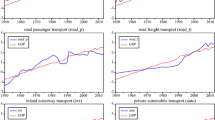Abstract
The aftermath of the financial crisis has threatened the stability of several financial institutions over the past years. Most heavily hit were banks with a notable exposure to ship finance, who saw the collateral value of many loans being diminished. Industry observers trace back the rare occurrence of actual defaults of ship loans to the use of the Long-Term-Asset Value (LTAV), a valuation method explicitly designed for ship investments. As the LTAV is based on a discounted cash-flow approach, it accounts for investment risks in the discount rate. Consequently, the LTAV bundles the time value of money and risk in a single value, which begs the question if this method oversimplifies the incorporation of risk in the evaluation of ship investments. In the context of infrastructure investments, the Decoupled Net Present Value (DNPV) has recently been proposed as an alternative method that addresses the problem of using risk-adjusted discount rates. It separates the time value of money from risks by quantifying risk factors individually and treating them as costs to the investment. We provide a proof-of-concept regarding the applicability of the DNPV in the context of ship investments. To this end, we develop a DNPV valuation model and instantiate a prototype in Python. We then perform a simulation study that evaluates a ship investment using both the LTAV and the DNPV. The results of our study confirm the applicability of the DNPV to ship investments and point to both its advantages and limitations compared to the LTAV.
Access this chapter
Tax calculation will be finalised at checkout
Purchases are for personal use only
Similar content being viewed by others
References
Carmichael, D. G. (2016). Adjustments within discount rates to cater for uncertainty - Guidelines. The Engineering Economist, 1–14.
Espinoza, D. (2014). Separating project risk from the time value of money: a step toward integration of risk management and valuation of infrastructure investments. International Journal of Project Management, 32, 1056–1072.
Espinoza, D., & Morris, J. W. (2013). Decoupled NPV: A simple, improved method to value infrastructure investments. Construction Management and Economics, 31(5), 471–496.
Espinoza, D., & Rojo, J. (2015). Using DNPV for valuing investments in the energy sector: A solar project case study. Renewable Energy, 75, 44–49.
Hartwig, T. (2016). Maritime Overview 11/2016. Ernst Russ Shipbroker GmbH & Co.KG
Krüger, P., Landier, A., & Thesmar, D. (2015). The WACC fallacy: The real effects of using a unique discount rate. The Journal of Finance, 70(3), 1253–1285.
Mayr, D. (2015). Valuing vessels. In O. Schinas, C. Grau, & M. Johns (Eds.), HSBA Handbook on Ship Finance (pp. 141–163)
Robichek, A., & Myers, S. (1966). Conceptual problems in the use of risk-adjusted discount rates. The Journal of Finance, 21(4), 727–730.
Vereinigung Hamburger Schiffsmakler und Schiffsagenten e.V.: Long-Term Asset Value Parameter Diskontierungssatz zum 1. Oktober 2016. Private communication, 28.06.2017
Author information
Authors and Affiliations
Corresponding author
Editor information
Editors and Affiliations
Rights and permissions
Copyright information
© 2018 Springer International Publishing AG, part of Springer Nature
About this paper
Cite this paper
Schrader, P., Piel, JH., Breitner, M.H. (2018). Decoupled Net Present Value—An Alternative to the Long-Term Asset Value in the Evaluation of Ship Investments?. In: Kliewer, N., Ehmke, J., Borndörfer, R. (eds) Operations Research Proceedings 2017. Operations Research Proceedings. Springer, Cham. https://doi.org/10.1007/978-3-319-89920-6_37
Download citation
DOI: https://doi.org/10.1007/978-3-319-89920-6_37
Published:
Publisher Name: Springer, Cham
Print ISBN: 978-3-319-89919-0
Online ISBN: 978-3-319-89920-6
eBook Packages: Business and ManagementBusiness and Management (R0)




